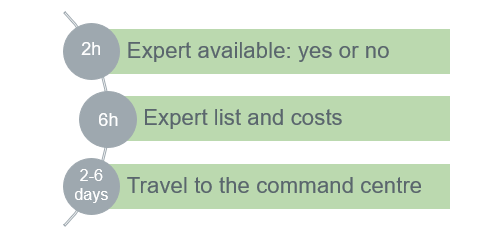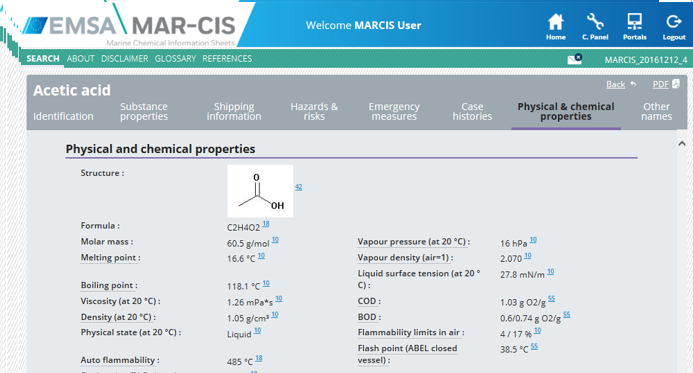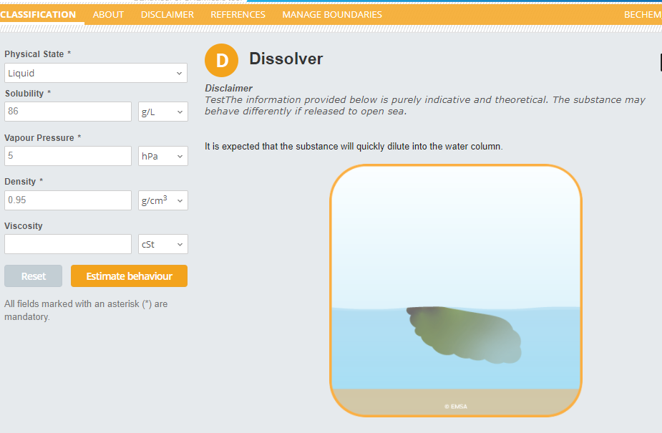Marine Intervention in Chemical Emergencies Network (MAR-ICE service)
To support the affected coastal States in the response to maritime incidents involving chemicals or hazardous and noxious substances (HNS) EMSA focuses on the rapid provision of expert information and advice on chemical substances to support the requesting party’s decision-making process during an emergency.
In close cooperation with the European Chemical Industry Council (Cefic) and the Centre of Documentation, Research and Experimentation on Accidental Water Pollution (Cedre, France), EMSA established a network of experts (MAR-ICE Network) who provide upon request product-specific information and specialist advice on chemicals involved in maritime emergencies, both remotely (MAR-ICE level 1) and on-site at the requester’s command centre (MAR-ICE level 2). The MAR-ICE Network is available 24/7 to EU Member States, EFTA coastal States, and coastal EU Candidate Countries via a dedicated contact point and is based on the voluntary ICE (Intervention in Chemical transport Emergencies) network, which provides a similar type of assistance for land-based chemical incidents.
National authorities benefit from 24/7 access to a chemist specialised on marine pollution response, whom they can consult for professional information, documentation and advice on chemical products and their associated risks. The service can be activated via contact numbers and operational procedures (including the MAR-ICE Activation Form) which have been distributed to national maritime administrations and which are also available on EMSA’s password-protected extranet.
Key aspects of the MAR-ICE Network
MAR-ICE Level 1 support: The MAR-ICE network offers remotely and free of charge, through a single contact point, product and incident-specific information and expert advice within 1 hour of the request and more detailed information shortly thereafter
The information provided includes:
- Relevant substance-specific documentation
- Additional expert advice on specific product properties and hazards through direct contact with a knowledgeable chemical company.
Furthermore, and on a case-by-case basis, the service provides:
- Risk assessment for responders and the environment
- Drift and weathering modelling results, indicating areas potentially impacted by the released chemical
- Advice on response methods and options.
MAR-ICE Level 2 support: When activating the service for on-site expertise, i.e. receiving a chemical expert at the command centre of the requesting country (MAR-ICE level 2), in addition to what is provided under level 1, the requester will know within 2-6 hours if and what type of chemical expertise is available to travel to the command centre to assist the response team on-site and if any costs apply.

With the MAR-ICE service, national authorities benefit from rapid access to a network of marine pollution response and chemical experts, via a dedicated single-contact point (MAR-ICE Contact Point), who can support them with expert information and substance-specific advice during the response to chemical spills.
Information and documentation provided via the MAR-ICE service includes the MAR-CIS information sheets and the BE-CHEM tool, described below
Key aspects of MAR-CIS
The MARine Chemical Information Sheets (MAR-CIS) have been developed for 217 chemical substances. The data for each substance can be easily viewed and exported by the database user.
The main information categories covered in MAR-CIS include:
- Substance identification; substance physical and chemical properties
- Shipping information (maritime transportation codes, GESAMP profile)
- Hazards and risks
- Emergency measures
The MAR-CIS information sheets have been provided to the relevant national competent authorities.
Access to MAR-CIS is also possible to the competent authorities through:
- A dedicated MAR-CIS web portal
- A MAR-CIS application for mobile devices
- EMSA’s Central Hazmat Database (CHD), containing a list of dangerous or polluting goods that have to be notified in the European Union’s maritime information and exchange system (SafeSeaNet) and relevant details from the applicable International Maritime Organisation (IMO) Conventions and Codes.
The MAR-CIS information sheets aim to facilitate rapid access to specialist product-specific information on chemicals and they complement existing information sources at national or regional level.

Key aspects of BE-CHEM
The BEhaviour of CHEMicals (BE-CHEM) tool complements the MAR-CIS information. The physical behaviour of chemical substances when released to the marine environment define, from the very beginning of the incident, the emergency response operations at sea.
The BE-CHEM tool can be used to theoretically estimate the physical behaviour of chemical substances once released to the environment, based on the input of certain physical and chemical properties of the substance.
It classifies the chemical substance in one of 13 different physical behaviour classes: 12 classes from the Bonn Agreement Behaviour Classification System (G, GD, E, ED, F, FE, FED, FD, D, DE, S, SD), and one more class, the Persistent slick forming substance (Fp) defined by the GESAMP expert Group.
For substances not in MAR-CIS database, the BE-CHEM can provide an indication on the expected behaviour of the chemical once it is released to the environment.

Related FAQs
- MAR-CIS - Marine chemical information sheet [leaflet]
- How can the MAR-ICE Network be activated?
- What is MAR-CIS?
- What is the Marine Intervention in Chemical Emergencies (MAR-ICE) service?
- Who can use MAR-CIS?
- Who can use the MAR-ICE service?
- What can EMSA do in case of marine spills of hazardous and noxious substances (HNS)?
